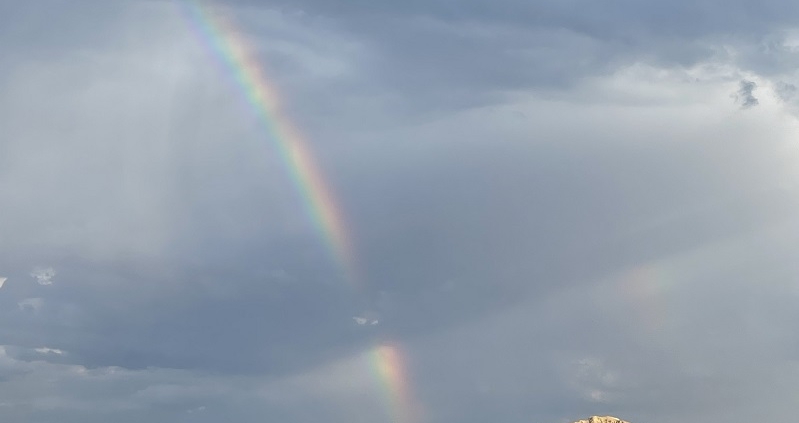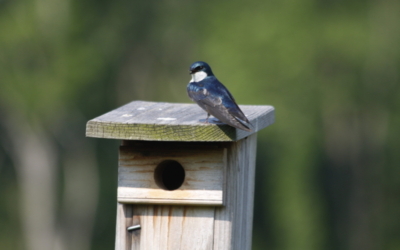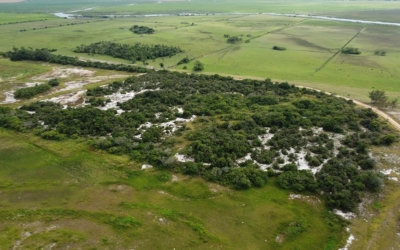Summit Materials | From Abandoned Sand Mine to Monarch Haven
An integral element of a strong corporate conservation program is the ability to learn from and adapt to nature. By recognizing what is working, and by utilizing already-existing features to further conservation goals, corporate conservationists can bring to fruition a program that supports biodiversity.
Construction materials company Summit Materials’ Cornejo Wildlife Project, located at Cornejo & Sons North Wichita Sand and Asphalt Plant 3 in Wichita, Kansas, is a prime example of a program achieving success by learning from nature. Originally an abandoned airport that was turned into a sand mine, the Cornejo Wildlife Project encompasses wetlands, landscaped gardens and a grassland, with efforts focused on supporting birds and pollinators and providing educational opportunities for employees and their families.
As the Cornejo Wildlife Project is located near the Arkansas River Corridor Habitat, it is an ideal stopover location for migratory birds. Five bluebird nesting boxes were installed across two locations on-site, situated away from roads and site operations to reduce potential human interference. In addition to the nesting boxes, Cornejo & Sons also installed several brush piles to provide shelter as well as foraging areas for target bird species.
One of the key conservation goals of the Cornejo Wildlife Project is the protection of pollinators, particularly migratory monarch butterflies, since the garden is located within the I-35 Monarch Highway. The site’s several gardens help support this goal, including a 200-square-foot pollinator garden containing milkweed, garden phlox and black-eyed Susan to provide resources for monarchs.
“One major issue we ran into was getting water to our pollinator garden,” said Randy Roths, Community Outreach Director at Cornejo & Sons. “We tried many different methods to resolve this: rain collection barrels with a hose line, a water line from the lake that got filled with pond scum, soaker hose that kept getting stopped up, etc.” After learning from this trial-and-error period, the team found their winning option in an innovative solar-powered pump that transports water from the nearby pond into a sprinkler system to irrigate the garden. Beginning in early 2021, Cornejo & Sons also employed a no-pesticide policy in the pollinator garden, and in 2022, approximately 42 butterflies, bees, moths and wasps were observed throughout the garden.
Additional gardens at the plant entrance were in place for many years when Cornejo & Sons recognized that this area represented another opportunity to provide wildlife habitat on-site. Beginning in April 2021, the team removed overgrown plants and added milkweed and catmint based on these plants’ previous success with attracting pollinators in other locations on-site. These choices proved successful in this garden as well, with catmint and blazing stars attracting both bees and butterflies.
When the site was first purchased, a large berm along the southern end of the property separated the on-site quarry from a housing development. It was originally seeded with turfgrass, and Cornejo & Sons soon realized it could provide greater ecosystem services if it were seeded with pollinator-friendly plants instead. After over-seeding with several different wildflower mixes, the berm now hosts a variety of plants benefiting butterflies and bees, including purple prairie clover and yellow sweet clover. A no-mow policy ensures that these plants and the pollinators that depend on them can thrive. Just through visual observations alone, Cornejo & Sons could see the success of this garden, as the blooming flowers were buzzing with an estimated 5,000 individual bees.
But it’s not only the wildlife that gets to enjoy the Cornejo Wildlife Project — summer interns, employees and their families can tour the site. Through these tours, they learn about how the pollinator garden provides resources for bee populations, how the bluebird nests create shelter and how the site’s wetlands and riverside grasslands supply a water source for wildlife. This project also creates opportunities for learners to get involved in the maintenance of the habitat, either through planting native wildflowers or collecting samples to test the water quality. Making these hands-on projects accessible and family-friendly was a critical element. “We implemented weekend workdays that incorporated people’s families,” said Roths. “That way, they wouldn’t sacrifice their time away from their families in order to help out the project.”
When it comes to developing a successful conservation program, Roths emphasized the importance of looking to colleagues for support. “Ask for help,” he said. “You will be surprised in the interest and knowledge of other employees.”
Related Content:
- Blogs
- Webinars
- Preparing for Pollinators: A Guide for Attracting Pollinators All Season
- Building Insect Hotels: Enhancing Hospitality for Bugs, Bees and Beetles
- Protecting Our Most Vital Resource: Working Together for Watershed Conservation
- Looking out for Pollinators: Strengthening Pollinator Projects through Monitoring and Citizen Science
- Beyond the Pollinator Garden: How to Make the Greatest Impacts for Bees and Butterflies
- Native Bees: Bringing Essential Species Back to Your Habitat
- Project Guidances:
- White Papers
Quick Facts
| Site Name: | Cornejo Wildlife Project |
|---|---|
| Category: | Member Spotlight |
| Site Location: | Wichita, Kansas |
| Partners: | Boeing, Disney’s Animal Kingdom, Emporia State University, Great Plains Nature Center, K-State Research and Extension, Kansas Department of Wildlife, Kansas State University, Ruby Consulting, Sedgwick County Extension Office |
| Project Types: | Avian, Awareness and Engagement, Grasslands, Landscaped, Pollinators, Wetlands and Water Bodies |
| Certification Since: | 2018 |
| Certification Level: | Gold Certified |
| WHC Index Link: | Learn more about the program |


